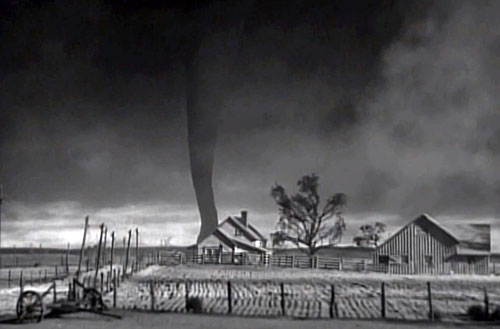The T-Word You Couldn’t Talk About

In the 1939 movie “The Wizard of Oz,” a tornado strikes a small town in Kansas. The cyclone catches the townspeople by surprise; our protagonist, Dorothy, is fortunate to find shelter before it is too late. She survives but is somehow teleported to the Munchkin Land region of the world of Oz. How such transportation works is anyone’s guess, but it has nothing to do with our story today. Let’s instead focus on another question: why didn’t the weatherman warn Kansas that tornadoes may be forming?
The answer: it’s a fictional movie based on a novel which is, similarly, fiction. The real world also lacks flying monkeys, ostensibly magical ruby slippers, brainless yet sentient scarecrows, or horses of many colors. But that aside, there’s another, real-life reason: weathermen of the day weren’t allowed to talk about tornadoes.
By 1939, the radio was common enough where, in case of emergency, there was a reliable way to reach a lot of people. And certainly, weather can cause an emergency. But if you were really in Kansas that day — and, assuming, there really was a tornado — you wouldn’t have heard the weatherman predict that a tornado was coming. Part of the reason was that we weren’t very good at predicting tornadoes anyway. Take, for example, the weather report before the Tri-State Tornado of 1925, which from a loss-of-life perspective, the worst in American history to date. The storm claimed approximately 700 lives across parts of Missouri, Indiana, and Illinois, injured as many as 2,000 others, and destroyed countless farms, buildings, and wiped a few towns off the map. Yet, almost no one had any reason to know that such a disaster was coming beforehand. As Popular Mechanics reported, “the forecast for the central Midwest on March 18, 1925 [the day of the tornado] was for showers and cooling temperatures — nothing out of the ordinary.”
It’s possible, if not likely, that these early meteorologists simply didn’t know how to read the information they had in front of them, and that they didn’t predict severe storms because they didn’t truly think any were on the horizon. But even if they had, weathermen of the day wouldn’t have issued a tornado warning — they weren’t allowed to. It was too dangerous.
The website of the Storm Prediction Center of the National Oceanic and Atmospheric Administration (“NOAA”) explained that, “before 1950, at various stages of development of the Weather Bureau, the use of the word “tornado” in forecasts was at times strongly discouraged and at other times forbidden, because of a fear that predicting tornadoes may cause panic.” Slate, quoting another historian, notes that even mentioning a tornado was tantamount to “career suicide.” It was simply too difficult to accurately predict tornadoes, and the risk of publicly doing so could cause harm itself, as it could send people into hysterics. And that may have caused more harm than an actual tornado would.
As our ability to accurately predict tornadoes increased, the risk of a false alarm abated significantly. In the summer of 1950, the Weather Service revoked any guidance suggesting that the word “tornado” not be used (pdf).
Bonus fact: During the War of 1812, British troops marched on Washington, D.C., and set it aflame, burning down parts of the White House, Capitol, and many other buildings. But it could have been worse. A tornado hit the city as the British were leaving, certainly bringing more damage to some buildings, but also bringing something else: rain. According to Smithsonian magazine, “the rain continued for two hours, dousing the flames.”
From the Archives: Umbrella Lottery: How the National Weather Service (and others) determine what the “chance of rain” is.
